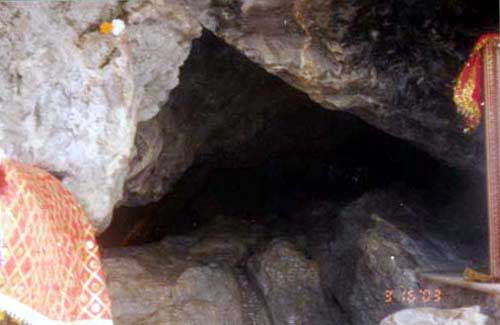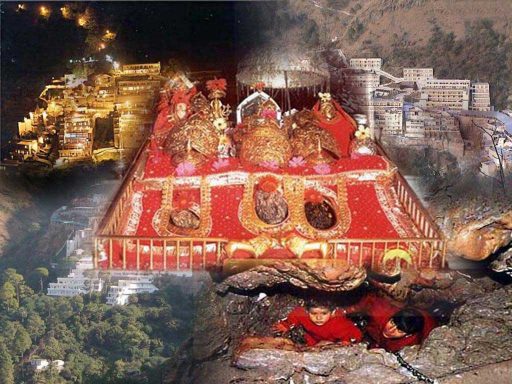
Shri Mata Vaishno Holy Shrine Cave
According to Hindu epic, Maa Vaishno Devi took birth in the South of India in the home of Ratnakar Sagar, Her worldly parents had remained childless for a long time. Ratnakar had promised, the night before the birth of the Divine child, that he would not come in the way of whatever his child desired. Ma Vaishno Devi was called Trikuta as a child. Later She was called Vaishnavi because of Her taking birth from Lord Vishnu’s lineage. When Trikuta was 9 years old, She sought her father’s permission for doing penance on the seashore. Trikuta prayed to Lord Vishnu in the form of Rama. During Shree Rama’s search for Sita, He reached the seashore along with His army. His eyes fell on this Divine Girl in deep meditation. Trikuta told Shree Rama that She had accepted Him as Her husband. Shree Rama told Her that during this Incarnation He had vowed to be faithful to only Sita. However the Lord assured Her that in Kaliyuga He would manifest as Kalki and would marry Her.
In the meantime Shree Rama asked Trikuta to meditate in the cave found in the Trikuta Range of Manik Mountains, situated in Northern India. Ma decided to observe the ‘Navratra’ for the Victory of Shree Rama against Ravan. Hence one reads the Ramayana during the 9 days of Navratra, in remembrance of the above connection. Shree Rama promised that the whole world would sing Ma Vaishno Devi’s praise. Trikuta was to become famous as Vaishno Devi and would become immortal forever.
With the passage of time many more stories about the Mother Goddess emerged. One such story is about Shree-Dhar.
Shree-Dhar was an ardent devotee of Ma Vaishno Devi. He resided in a village called Hansali, 2 km away from the present Katra town. Once Ma appeared to him in the form of a young bewitching girl. The young girl asked the humble Pandit to hold a ‘Bhandara’. (A feast to feed the mendicants and devotees) The Pandit set out to invite people from the village and near-by places. He also invited ‘Bhairav Nath’ a selfish demon. Bhairav Nath asked Shri-Dhar how he was planning to fulfill the requirements. He reminded him of the bad consequences in case of failure. As Panditji was lost in worry, the Divine girl appeared and told Him not to be despondent as everything had been arranged. She asked that over 360 devotees be seated in the small hut. True to Her word the Bhandara went smoothly with food and place to spare.
Bhairav Nath admitted that the girl had supernatural powers and decided to test Her further. He followed the Divine girl to Trikuta Hills. For 9 months Bhairav Nath was searching for the mystic girl in the mountains, whom he believed was an incarnation of the Mother Goddess. While running away from Bhairav, Devi shot an arrow into the Earth from which water gushed out. The resultant river is known as Baanganga. It is believed that by taking a bath in Baanganga (Baan: Arrow), a believer of the Mother Goddess can wash away all his sins. The banks of the river, known as Charan Paduka, are marked by Devi’s foot imprints, which remains intact till date. Vaishno Devi then took shelter in a cave known as Garbh Joon near Adhkawari where she meditated for 9 months attaining spiritual wisdom and powers. Her meditation was cut short when Bhairav located her. Vaishno Devi was then compelled to take the form of Maha Kali when Bhairav tried to kill her. The manifestation of the Mother Goddess took place at the mouth of the Holy cave at Darbar. The Goddess then beheaded Bhairav with such sheer force, that his skull fell at a place known as Bhairav Ghati, 2.5 km from the Holy Cave.
In his dying moments, Bhairav pleaded for forgiveness. The Goddess knew that Bhairav’s main intention in attacking her was to achieve salvation. She not only granted Bhairav liberation from the cycle of reincarnation, but also granted him a boon, whereby every devotee, in order to ensure completion of the pilgrimage, had to visit Bhairav Nath’s temple near the Holy cave after the darshan of the Goddess.Meanwhile Vaishno Devi assumed the shape of a rock with three pindis (heads) and immersed herself into meditation forever.
Meanwhile Pandit Shree-Dhar became impatient. He started to march towards Trikuta Mountain on the same path that he had witnessed in a dream. He ultimately reached the cave mouth. He made a daily routine of worshiping the ‘Pindis’ in several ways. His worship pleased the Goddess. She appeared in front of him and blessed him. Since that day, Shree-Dhar and his descendants have been worshiping the Goddess Mother Vaishno Devi.
History of the Holy Shrine of Maa Vaishno Devi

Maa Vaishno Devi Temple
Like with most old Shrines, it is not possible to ascertain when exactly the pilgrimage to the Holy Shrine started. A geological study of the Holy Cave has indicated its age to be nearly a million years. Vedic literature gives no reference to the worship of any female deity, although the mountain Trikuta does find its mention in Rigveda, the oldest of the four Vedas The practice of worshipping Shakti, largely started in the Puranic period.
The first mention of the Mother Goddess is in the epic Mahabharat. When the armies of Pandavs and Kaurvas were arrayed in the battlefield of Kurukshetra, Arjun, the chief warrior of Pandavs upon advice of Sri Krishna; meditated upon the Mother Goddess and sought Her blessings for victory. This is when Arjun addresses the Mother Goddess as ‘Jambookatak Chityaishu Nityam Sannihitalaye’, which means ‘you who always dwell in the temple on the slope of the mountain in Jamboo’ (probably referring to the present day Jammu).
It is also generally believed that the Pandavs were the first to build the temples at Kol Kandoli and Bhawan in reverence and gratitude for the Mother Goddess. On a mountain, just adjacent to the Trikuta Mountain and overlooking the Holy Cave are five stone structures, which are believed to be the rock symbols of the five Pandavs.
Perhaps the oldest reference of the visit of a historical figure to the Holy Cave is that of Guru Gobind Singh who is said to have gone there via Purmandal. The old foot track to the Holy Cave passed through this well-known pilgrimage centre.
Some traditions believe this Shrine to be the holiest of all Shaktipeeths (a place where the Mother Goddess, the Eternal Energy has Her abode) since the skull of Mata Sati fell here. Others believe that her right arm had fallen here. But some scriptures do not agree with it. They do agree that at a place called Gandarbal in Kashmir, the right arm of Sati had fallen. Nevertheless, in the Holy Cave of Shri Mata Vaishno Deviji, one does find stone remains of a human hand, popularly known as Varad Hast (the hand that grants boons and blessings).
Special thanks to Purana & Vedas from Where the accurate information is collected. And thanks to these site & other sites on the Web for content help and images & other research for advance writing: